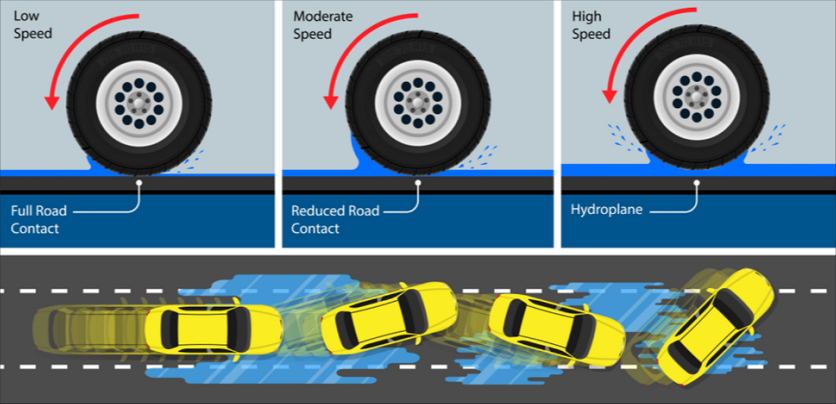With the very wet weather we have been having, here is some aquaplaning risk reduction advice to keep yourself and your drivers safe.
Having tyres with good tread helps reduce risk. How good is the tread on your tyres? If in doubt – check out our article on tyre tread, pressure and general safety.
Aquaplaning (hydroplaning to our American friends)
When a car is standing (parked) on a wet road the weight of the car will push any water aside, so the tyres stay in contact with the surface. Once it is travelling, the water on the surface is usually dispersed around either the tyres or through the tread pattern.
As the speed of the car rises though, there is less time to disperse that water – and this becomes even more difficult where the standing water increases in depth, when the tyres are much wider and/or the tyres have less depth of tread pattern.
The water starts to build up a wedge in front of the tyres – just like a wedge of pastry in front of a cook’s rolling pin – until eventually the water forces its way under the tyres and the car is ‘aquaplaning’ – or ‘water-skiing’ – floating, skimming over the surface, not in contact with the road.
That’s very bad news. And in case you hadn’t guessed steering is only possible when tyres are in contact with the road!
What causes hydroplaning?
Hydroplaning is caused by a combination of standing water on the road surface, tyres with reduced tread depth and high speeds.
- Standing water on the surface – not just a wet road surface. The deeper the water, the more likely it is to happen.
- Tyres with reduced tread depth – around the legal limit (which is why we recommend you change your tyres at 2.0mm or more of tread). It’s also more likely with wider tyres, as it is harder for the water to flow ‘around’ the side of the tyre
- Higher speeds – 60mph or more.
- All of these factors together will almost guarantee a loss of grip.
What can you do to avoid hydroplaning?
- You can’t make the water go away – but you can avoid areas of standing water. Choose a different route if you know standing water gathers in some areas – or steer around it, or at least away from the deepest area. Even aiming to keep 2 of the 4 wheels on the tarmac to maintain directional control is a benefit.
- Keep your road speed lower – before you hit the water, especially when there is the likelihood of standing water – and especially at night, where it might not be easy to see pools of standing water.
- Be sure your tyres have good tread. If approaching that ‘end-of-life’ point where you know tread is low slow down even more before hitting the surface water, don’t let it happen to you.
What can you do when your car is aquaplaning?
- Not a lot, since your tyres are no longer in contact with the road…
- This is why aquaplaning is so dangerous – and why preventing it from happening in the first place is so important.
- Fortunately, most of the time the car aquaplanes only briefly while crossing a puddle – but if the puddle/standing water is elongated… it’s not good.
- Keep your wheels straight and keep off the pedals. When the grip is regained this is the time to start to steer and to brake gently – not before.
- Avoid steering to the side while the contact is lost, otherwise, when contact is regained you may suddenly swerve sharply and lose control.
Note that the worst possible scenario is when you are on a slight bend. Normally your will tyres guide you round the bend, but as soon road contact is lost, your car will travel (drift uncontrolled) in a straight line.
There is a strong temptation to steer to follow the road line. This will be ineffective as there is no contact with the road. If the steering is applied once the tyres regain contact with the road the resulting sideways ‘kick’ may throw you sideways out of control.
Remember: DEEP WATER? WORN TYRES? HIGHER SPEEDS? SLOW DOWN!
Looking for guidance on driver safety for your fleet? Contact us on [email protected] or check out our fleet products, we’d love to help you.



